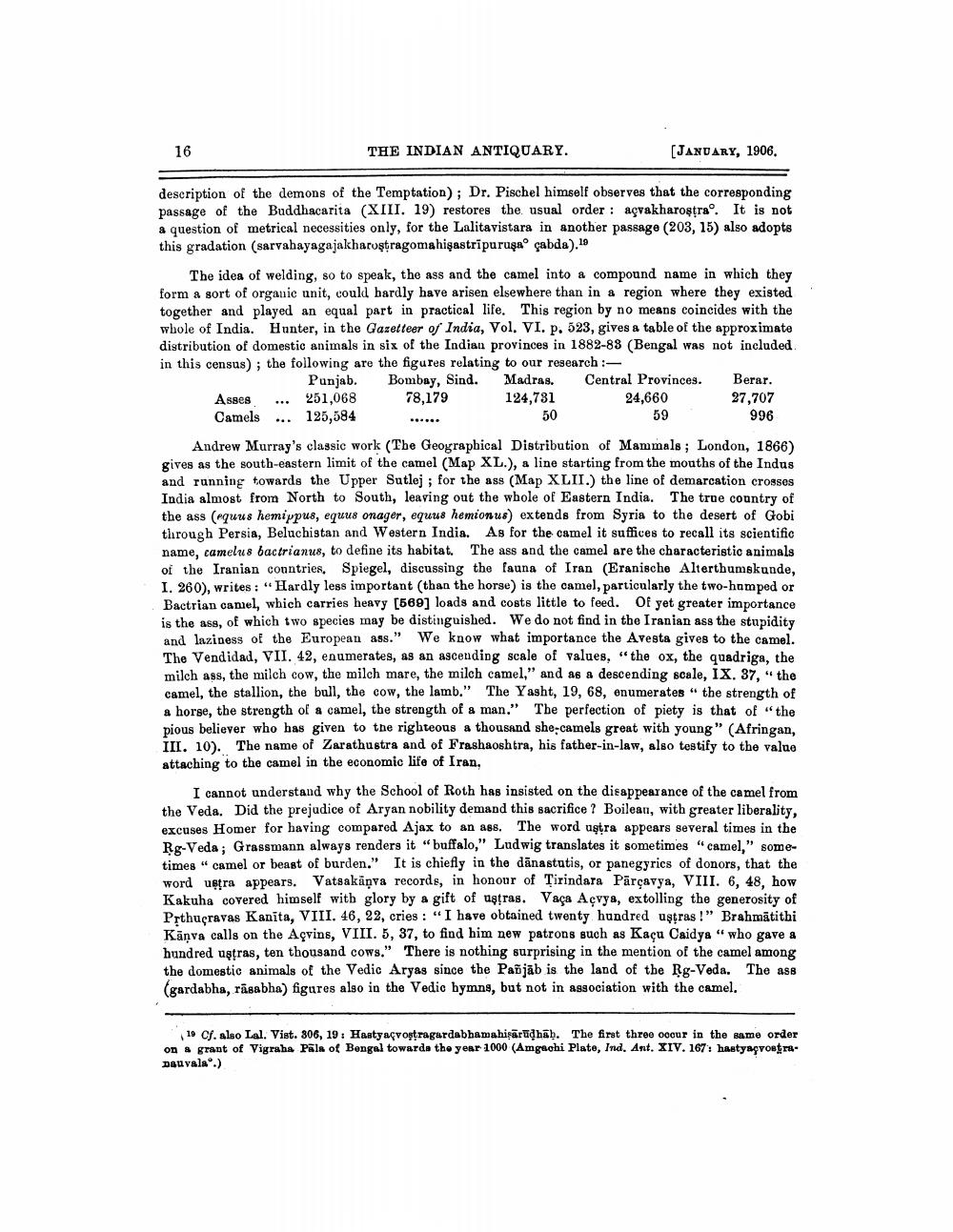________________
16
THE INDIAN ANTIQUARY.
(JANUARY, 1906.
description of the demons of the Temptation); Dr. Pischel himself observes that the corresponding passage of the Buddhacarita (XIII. 19) restores the usual order : acvakharoştrao. It is not a question of metrical necessities only, for the Lalitavistara in another passage (203, 15) also adopts this gradation (sarvahayagajakharustragomahişastripuruşa çabda).10
The idea of welding, so to speak, the ass and the camel into a compound name in which they form a sort of organic unit, could hardly have arisen elsewhere than in a region where they existed together and played an equal part in practical life. This region by no means coincides with the whole of India. Hunter, in the Gazetteer of India, Vol. VI. p. 523, gives a table of the approximate distribution of domestic animals in six of the Indian provinces in 1882-88 (Bengal was not included in this census); the following are the figures relating to our research :
Punjab. Bombay, Sind. Madras. Central Provinces. Berar. Asses ... 251,068 78,179 124,731
24,660 27,707 Camels ... 125,584
50
59
996
Andrew Murray's classic work (The Geographical Distribution of Mammals; London, 1866) gives as the south-eastern limit of the camel (Map XL.), a line starting from the mouths of the Indus and running towards the Upper Sutlej ; for the ass (Map XLII.) the line of demarcation crosses India almost from North to South, leaving out the whole of Eastern India. The true country of the ass (equus hemippus, equus onager, equus hemionus) extends from Syria to the desert of Gobi through Persia, Beluchistan and Western India. As for the camel it suffices to recall its scientific name, cameluis bactrianus, to define its habitat. The ass and the camel are the characteristic animals of the Iranian countries. Spiegel, discussing the fauna of Iran (Eranische Alterthumskunde, I. 260), writes: "Hardly less important than the horse) is the camel, particularly the two-humped or Bactrian canel, which carries heavy [569] loads and costs little to feed. Of yet greater importance is the ass, of which two species may be distinguished. We do not find in the Iranian ass the stupidity and laziness of the European ass." We know what importance the Avesta gives to the camel. The Vendidad, VII. 42, enumerates, as an ascending scale of values, "the ox, the quadriga, the milch ass, the milch cow, the milch mare, the milch camel," and as a descending scale, IX. 37, "the camel, the stallion, the ball, the cow, the lamb." The Yasht, 19, 68, enumerates " the strength of a horse, the strength of a camel, the strength of a man." The perfection of piety is that of the pious believer who has given to the righteous a thousand she camels great with young" (Afringan, III. 10). The name of Zarathustra and of Frashaoshtra, his father-in-law, also testify to the value attaching to the camel in the economic life of Iran,
I cannot understand why the School of Roth has insisted on the disappearance of the camel from the Veda. Did the prejudice of Aryan nobility demand this sacrifice ? Boilean, with greater liberality. excuses Homer for having compared Ajax to an ass. The word uatra appears everal times in the Rg-Veda; Grassmann always renders it "buffalo," Ludwig translates it sometimes camel," sometimes camel or beast of burden." It is chiefly in the dānastatis, or panegyrics of donors, that the word ußtra appears. Vatsakāņva records, in honour of Tirindara Pārçavya, VIII. 6, 48, how Kakuha covered himself with glory by a gift of uạtras. Vaça Açvya, extolling the generosity of Prthucravas Kanita, VIII. 46, 22, cries : "I have obtained twenty hundred uşțras!" Brahmätithi Kāņva calls on the Açvins, VIII. 5, 37, to find him new patrons such as Kaçu Caidya "who gave a hundred ustras, ten thousand cows." There is nothing surprising in the mention of the camel among the domestic animals of the Vedic Aryas since the Pañjāb is the land of the Rg-Veda. The ass (gardabha, rasabha) figures also in the Vedic hymns, but not in association with the camel.
19 Cf. also Lal. Vist. 306, 19: Hastya vostragardabhamahişārudhab. The first three oocur in the same order on a grant of Vigraha Pals of Bengal towards the year 1000 (Amgachi Plate, Ind. Ant. XIV. 167: hastya vostraDauvala.)




